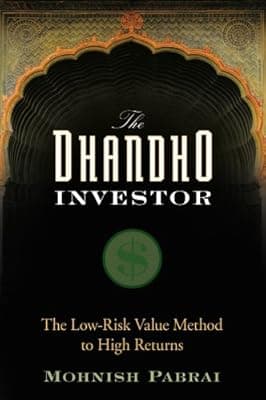
The Dhandho Investor: The Low-Risk Value Method to High Returns
by Mohnish Pabrai
7 highlights
Highlights
He was on the hunt for three years. He patiently waited for the right deal to materialize. Classically, his story is all about “Few Bets, Big Bets, Infrequent Bets.” And it’s all about only participating in coin tosses where “Heads, I win; tails, I don’t lose much!”
Location 400
My take on Virgin Atlantic is simply this: if you can start a business that requires a $200 million 747 jumbo jet and a boatload of employees in a tightly regulated industry for virtually no capital, then virtually any business that you want to start can be gotten off the ground with minimal capital. All you need to do is replace capital with creative thinking and solutions.
Location 449
He said, quite nonchalantly, that Marwari businesspeople, even with only a fifth-grade education, simply expect all their invested capital to be returned in the form of dividends in no more than three years. They expect that, after having gotten their money back, their principal investment continues to be worth at least what they invested in it. They expect these to be ultra low-risk bets. Now, folks, this is really good stuff—they don’t teach this at the Harvard Business School. If you simply used this Marwari formula before making any investments, let me assure you of two things: 1. You’d take a quick pass on most investments offered to you; and 2. Starting with very little capital, after a few decades you’ll be very wealthy. Enough said.
Location 527
And that’s the Dhandho framework. To summarize: • Invest in existing businesses. • Invest in simple businesses. • Invest in distressed businesses in distressed industries. • Invest in businesses with durable moats. • Few bets, big bets, and infrequent bets. • Fixate on arbitrage. • Margin of safety—always. • Invest in low-risk, high-uncertainty businesses. • Invest in the copycats rather than the innovators.
Location 734
Microsoft’s founders, Bill Gates and Paul Allen, were exceptionally bright, talented, and hard-working. Microsoft got started in the mid-1970s, developing BASIC language compiles for the earliest microcomputers that were beginning to appear on the horizon. The pivotal deal for the fledgling company in 1980 was a deal with IBM to deliver MS-DOS for the personal computer (PC) that IBM planned to introduce. There was just one problem: Microsoft did not have an operating system suitable for the PC to sell to IBM. That did not stop Microsoft. They convinced IBM that Microsoft had an operating system under development and they could deliver within IBM’s timeframes.12 It was a lie. Microsoft then went out and bought all rights to Quick and Dirty Operating System (QDOS) from a tiny outfit named Seattle Computer for $50,000. QDOS, modified by Microsoft, became MS-DOS and IBM-DOS.13 The flagship product that allowed Microsoft to scale exponentially wasn’t developed in-house. It was lifted from Seattle Computer.
Location 1941
If I were given just two investment choices of Google or Microsoft at present prices, it is a no-brainer decision for me. I’d pick Microsoft all day long. It is a battle between an innovator versus a cloner. Good cloners are great businesses. Innovation is a crapshoot, but cloning is for sure.
Location 1980
1. Is it a business I understand very well—squarely within my circle of competence? 2. Do I know the intrinsic value of the business today and, with a high degree of confidence, how it is likely to change over the next few years? 3. Is the business priced at a large discount to its intrinsic value today and in two to three years? Over 50 percent? 4. Would I be willing to invest a large part of my net worth into this business? 5. Is the downside minimal? 6. Does the business have a moat? 7. Is it run by able and honest managers?
Location 2156